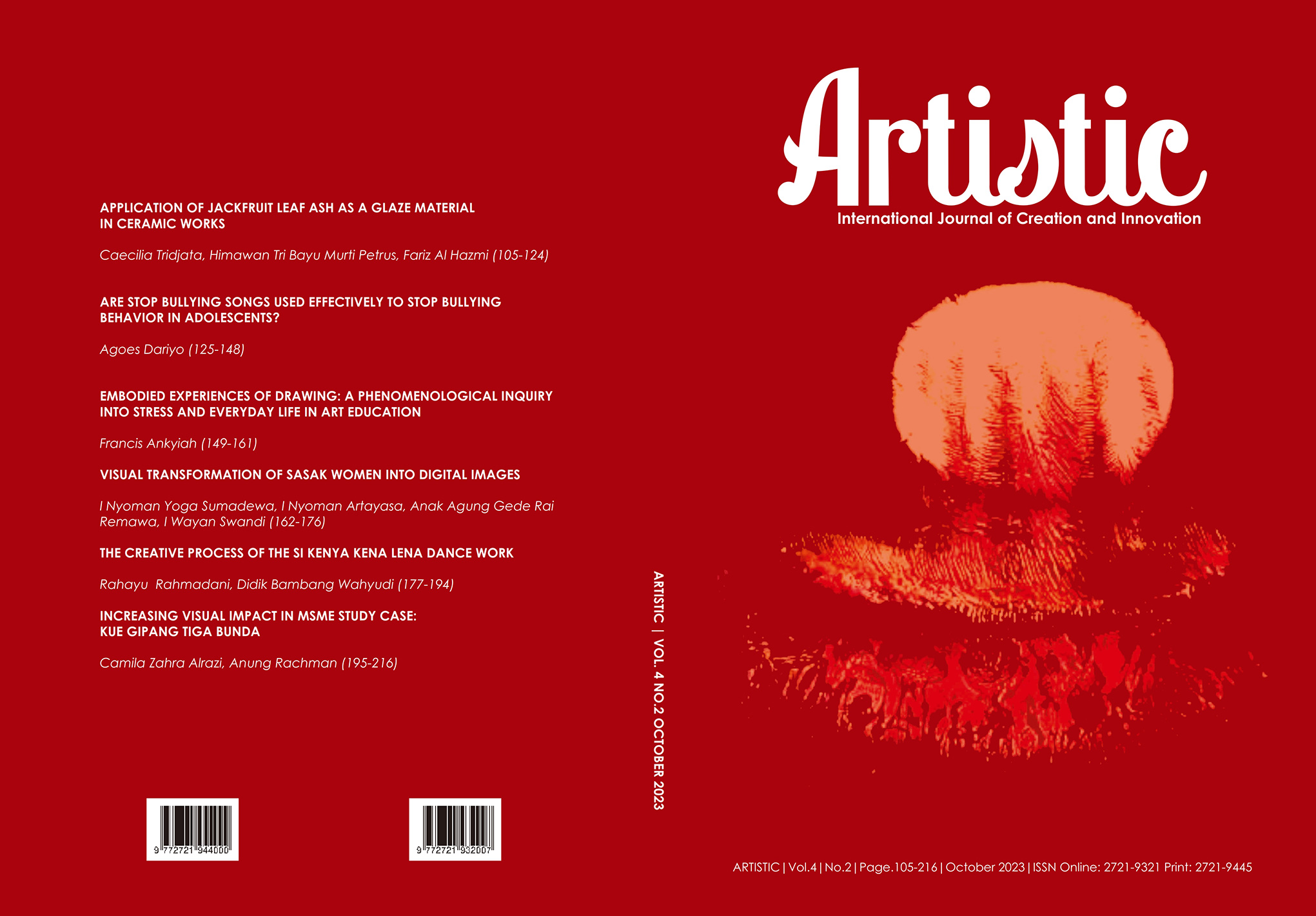EMBODIED EXPERIENCES OF DRAWING: A PHENOMENOLOGICAL INQUIRY INTO STRESS AND EVERYDAY LIFE IN ART EDUCATION
DOI:
https://doi.org/10.33153/artistic.v4i2.5556Keywords:
Drawing education, Phenomenology, Embodiment, lived experience, StresAbstract
Drawing's impact on students' stress levels and coping with daily life is underexplored. This study used a phenomenological approach to understand how undergraduates experience drawing in art studio courses. Five art students were interviewed during regular assignments, and Moustakas' method was used to analyse the data. Three themes emerged: drawing as an "escape" from worries, a mindfulness practice fostering relaxation and present moment awareness, and beneficial for stress management and coping skills applicable to other areas of life. Immersion in drawing cultivates mind-body awareness, aiding students in managing stress. It buffers academic demands and enhances overall well-being, but can also induce stress during heavy workloads. This study offers qualitative insights into drawing as stress relief and emotional regulation for art students navigating educational and everyday demands.
Downloads
References
Arps, B. (2007). Writin on Wayang: Approaches to Puppet Theatre in Java and Bali Bevan, M. T. (2014). A method of phenomenological interviewing. Qualitative Health Research, 24(1), 136–144. https://doi.org/10.1177/1049732313519710
Bolwerk, A., Mack-Andrick, J., Lang, F. R., Dörfler, A., & Maihöfner, C. (2014). How art changes your brain: Differential effects of visual art production and cognitive art evaluation on functional brain connectivity. PloS one, 9(7), e101035.
Celedón, P., Lanteigne, A., & Hill, C. (2018). Fear and trembling: The relation between task-irrelevant thoughts, performance quality, and adjunctive behaviors in drawing. Psychology of Aesthetics, Creativity, and the Arts, 12(1), 95–107. https://doi.org/10.1037/aca0000098
Chilton, G., Cannizzaro, S., & Dhar, N. (2013). Art therapy reduces fatigue and insomnia and increases bonus in office workers, Applied Psychophysiology and Biofeedback, 38(3), 121-130. https://doi.org/10.1007/s10484-013-9217-0
Coholic, D. A. (2011). Exploring the feasibility and benefits of arts-based mindfulness-based practices with young people in need: Aiming to assist with the fostering of resilience and creativecoping. Child and Youth Care Forum, 40(4), 303–317. https://doi.org/10.1007/s10566-010-9125-x
Creswell, J. W. (2007). Qualitative inquiry and research design: Choosing among five approaches (2nd ed.). Thousand Oaks, CA: Sage Publications.
Creswell, J. W., & Poth, C. N. (2018). Qualitative inquiry and research design: Choosing among five approaches (4th ed.). Thousand Oaks, CA: Sage Publications.
Csikszentmihalyi, M. (1990). Flow: The psychology of optimal experience. Harper Perennial.
Curry, N. A., & Kasser, T. (2005). Can coloring mandalas reduce anxiety? Art Therapy, 22(2), 81–85. https://doi.org/10.1080/07421656.2005.10129470
Czikszentmihalyi, M. (2008). Flow: The psychology of optimal experience. Harper Perennial Modern Classics.
Edwards, B. (1999). Drawing on the right side of the brain. TarcherPerigee.
Geertz, C. (1973). Thick description: Toward an interpretive theory of culture. In The interpretation of cultures: Selected essays (pp. 3-30). Basic Books.
King, L. A., Hicks, J. A., Krull, J. L., & Del Gaiso, A. K. (2013). Positive affect and the experience of meaning in life. American Psychological Association, 90(1), 179–196. https://doi.org/10.1037/a0029609
Malchiodi, C. A. (2012). Handbook of art therapy (2nd ed.). Guilford Press.
Moustakas, C. (1994). Phenomenological research methods. Thousand Oaks, CA: Sage Publications.
National Art Education Association. (2018). The national visual arts standards. Reston, VA: National Art Education Association.
Nyklíček, I., Mommersteeg, P. M. C., Van Beugen, S., Ramakers, C., & Van Boxtel, G. J. (2013). Mindfulness-based stress reduction and physiological activity during acute stress: A randomized controlled trial. Health Psychology, 32(10), 1110–1113. https://doi.org/10.1037/a0032200
Palinkas, L. A., Horwitz, S. M., Green, C. A., Wisdom, J. P., Duan, N., & Hoagwood, K. (2015). Purposeful sampling for qualitative data collection and analysis in mixed method implementation research. Administration and Policy in Mental Health, 42(5), 533–544. https://doi.org/10.1007/s10488-013-0528-y
Pennebaker, J. W., & Chung, C. K. (2007). Expressive writing, emotional upheavals, and health. In H. Friedman & R. Silver (Eds.), Foundations of health psychology (p. 263–284). Oxford University Press.
Roco, C. M., Wowk, M. T., & Schaefer, C. E. (2019). Art-making's influence on mindfulness and health: A scoping review. International Journal of Art Therapy, 24(3), 104–116. https://doi.org/10.1080/17454832.2018.1558702
Saldana, J. (2009). The coding manual for qualitative researchers. London: Sage Publications Ltd.
Sandmire, D. A., Gorham, S. R., Rankin, N. E., & Grimm, D. R. (2012). The influence of art making on anxiety: A pilot study. Art Therapy: Journal of the American Art Therapy Association, 29(2), 68–73. https://doi.org/10.1080/07421656.2012.683748
Smith, J. A., Flower, P., & Larkin, M. (2009). Interpretative phenomenological analysis: Theory, method and research. London: SAGE Publications Ltd. https://www.doi.org/10.4135/9781446207536
Van Manen, M. (1990). Researching lived experience: Human science for an action sensitive pedagogy. Albany, NY: SUNY Press.
Downloads
Published
How to Cite
Issue
Section
License
Copyright (c) 2024 Francis Ankyiah

This work is licensed under a Creative Commons Attribution-NonCommercial-ShareAlike 4.0 International License.
Copyright
Authors who publish with Artistic agree to the following terms:
- Authors retain copyright and grant the journal right of first publication with the work simultaneously licensed under a Creative Commons Attribution License (CC BY-SA 4.0) that allows others to share the work with an acknowledgment of the work's authorship and initial publication in this journal.
- Authors are able to enter into separate, additional contractual arrangements for the non-exclusive distribution of the journal's published version of the work (e.g., post it to an institutional repository or publish it in a book), with an acknowledgment of its initial publication in this journal.
This work is licensed under a Creative Commons Attribution-ShareAlike 4.0


